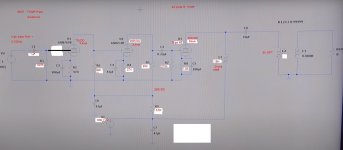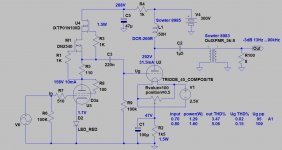IMHO for parafeed #45 the 15H plate choke is in the lower side, the bottom -3dB creeps up to 16..18 Hz.
The required plate choke is robust one, as -for example- Sowter 8985.
PLATE ANODE CHOKES
The required plate choke is robust one, as -for example- Sowter 8985.
PLATE ANODE CHOKES
Attachments
supernut,
For all those out there that want an approximate generalization they can use to calculate the choke for a Parafeed amplifier, to use with their favorite output tube:
Triodes: 45, 2A3, 300B; Triode Wired KT66 Beam Power, Triode wired EL34 Pentode, etc.
Find the output tube's plate resistance, rp.
Calculate the inductance of the choke that has inductive reactance at your desired low frequency -3dB bandwidth.
(assuming that the Parafeed coupling cap and output transformer -3dB bandwidth is much lower than the choke's -3dB low frequency). If those 2 frequencies are equal, that will be the - 6dB bandwidth.
Example: A 45 has an rp = 1700 Ohms.
Inductive reactance, Ohms, XL = 2 x pi x F x L
Lets pick 20Hz for a -3dB low frequency
So:
1700 Ohms = 2 x 3.14 x 20Hz x L
1700 Ohms / (2 x 3.14 x 20) = L
L = 13.5 Henry
But, some parafeed output transformers only have enough inductance, and enough laminations, so they are also -3dB at 20 Hz.
That means with the 13.5H choke, and output transformer we are -6dB at 20Hz.
Lets pick a choke with a little more inductance, enough for it to be -3dB at 10Hz.
1700 = 2 x 3.14 x 10 x L
L = 27 Henry
Lets say that an excellent parafeed output transformer is -1dB at 10 Hz, and that the choke is -3dB at 10Hz.
The result will be about -1.5dB at 20Hz.
And unless your speakers low frequency limit is much better than my best speakers,
You will not notice -1.5dB at 20Hz.
By the way, 10uF is 5000 Ohms capacitive reactance at 3.2Hz. But the inductive reactance of the 5000 Ohm output transformer will limit that response to be higher than 3.2Hz, since the primary inductance is in parallel with the 5000 Ohm primary load, when the secondary is loaded by 8 Ohms.
For all those out there that want an approximate generalization they can use to calculate the choke for a Parafeed amplifier, to use with their favorite output tube:
Triodes: 45, 2A3, 300B; Triode Wired KT66 Beam Power, Triode wired EL34 Pentode, etc.
Find the output tube's plate resistance, rp.
Calculate the inductance of the choke that has inductive reactance at your desired low frequency -3dB bandwidth.
(assuming that the Parafeed coupling cap and output transformer -3dB bandwidth is much lower than the choke's -3dB low frequency). If those 2 frequencies are equal, that will be the - 6dB bandwidth.
Example: A 45 has an rp = 1700 Ohms.
Inductive reactance, Ohms, XL = 2 x pi x F x L
Lets pick 20Hz for a -3dB low frequency
So:
1700 Ohms = 2 x 3.14 x 20Hz x L
1700 Ohms / (2 x 3.14 x 20) = L
L = 13.5 Henry
But, some parafeed output transformers only have enough inductance, and enough laminations, so they are also -3dB at 20 Hz.
That means with the 13.5H choke, and output transformer we are -6dB at 20Hz.
Lets pick a choke with a little more inductance, enough for it to be -3dB at 10Hz.
1700 = 2 x 3.14 x 10 x L
L = 27 Henry
Lets say that an excellent parafeed output transformer is -1dB at 10 Hz, and that the choke is -3dB at 10Hz.
The result will be about -1.5dB at 20Hz.
And unless your speakers low frequency limit is much better than my best speakers,
You will not notice -1.5dB at 20Hz.
By the way, 10uF is 5000 Ohms capacitive reactance at 3.2Hz. But the inductive reactance of the 5000 Ohm output transformer will limit that response to be higher than 3.2Hz, since the primary inductance is in parallel with the 5000 Ohm primary load, when the secondary is loaded by 8 Ohms.
Last edited:

